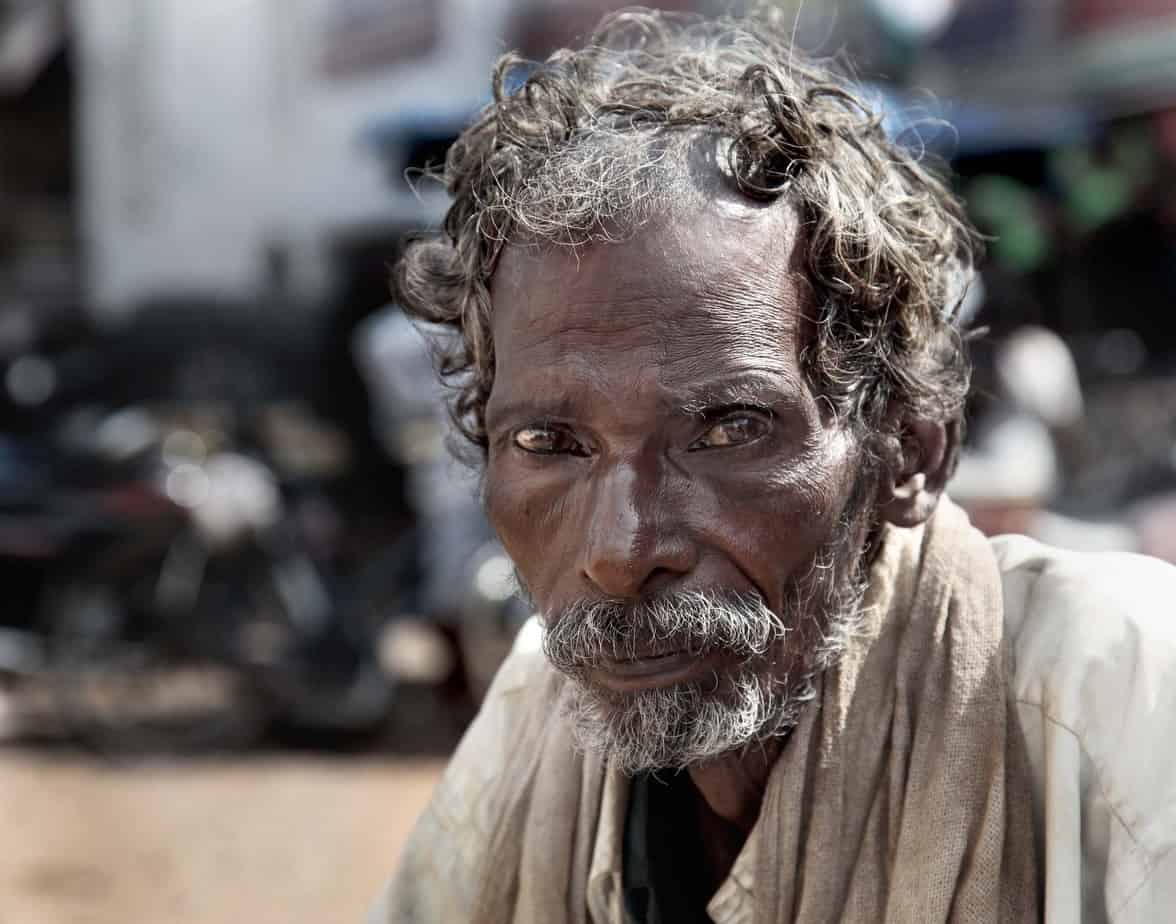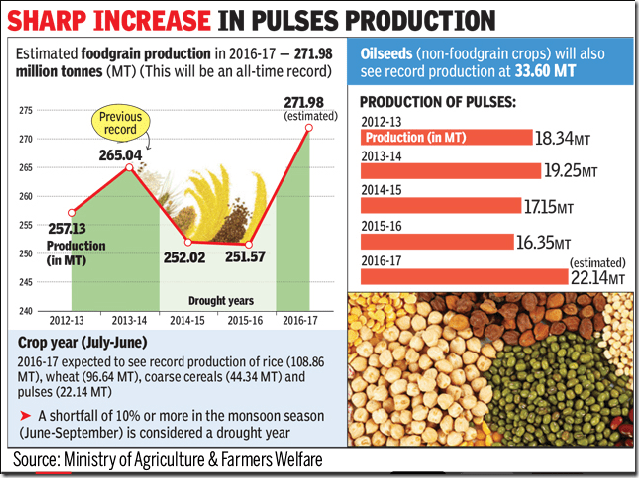The Real Reason Behind IFPRI’s Bad ‘Hunger Report’ On India

The latest Global Hunger Index report is out. And, India has fallen 45 ranks since 2014! Now, we are told that India is worse than Pakistan, Bangladesh, Nepal, Burma and even North Korea!! But, this is an incredible thing to say when the foodgrain production has set a new record!
Here is an informative infographic with the context of how the foodgrain production has moved over the years. The actual foodgrain production in 2016-17 was higher at 274 million tonnes (as opposed to an estimate of 271 mt)! Increase in pulses production was a whopping 37%!
Now, one needs to put this IFPRI “report” in perspective and look at it in context of the actual food production on the ground! In 2016-17, India had a record foodgrains production.
Robust output of wheat, rice and pulses pushed up India’s foodgrain production by 8.7% to a record high 273.38 million tonne during 2016-17, government data showed on Tuesday, increasing chances of lower food prices in the coming months.
After a heavy shower last year, rice output increased by 4.5% to a record 109.15 million tonne while wheat production was up 5.6% at all-time high of 97.44 million tonne. Coarse grains production rose 15.2% to highest ever 44.39 million tonne. What’s important, output of all major pulses jumped 37% to 22.40 million tonne, which may reduce dependence on imports and cool food inflation.
A record high output of grains, which contribute about 12.4% to the consumer inflation (CPI) basket, will increase supplies and moderate prices.
Mark the information that Wheat and Coarse grain production has been the highest EVER in India. These are the staple of the poor in India. Now, how can hunger increase when the same system is delivering record production of food to the Indian population. It just doesn’t pass the sniff test!
So, why is IFPRI – supposed to be an “independent body” – dinging India? What could be its motive?
IFPRI is a GMO Apologist
Vandana Shiva, the famous anti-GMO activist had written a well received article “The Seeds Of Suicide: How Monsanto Destroys Farming” holding Monsanto’s GMO seeds and their high prices along with the whole corporate strategy of making farmers dependent on their seeds forever, responsible for the increase in farmer’s suicides. We have written a detailed article on the clear link between Monsanto and Farmers’ Suicide while detailing what steps the Modi Government has taken to counter the suicides amongst the farmers – Indian Farmer Suicides: Reasons and 5 Critical Steps Modi Government Has Taken
We have to understand that GMO cotton – the Bt variety from Monsanto – was introduced in India in 2002. Since then, today 96% of all cotton production uses the Bt Cotton variety! In 2016, the Modi government imposed a 70% cut in the prices for Monsanto’s seeds, which the company protested aggressively! It then threatened to leave India – and put 96% of cotton production in jeopardy! Modi government gave it back – saying India is not scared. Why? Because Indian government laboratories were already readying an indigenous GMO variety so India needn’t be dependent on the foreign seed corporations.
Bt Cotton has led to farmer suicides
A study published in Environmental Sciences Europe suggested a linkbetween Bt cotton and farmers suicides. The study showed how Bt cotton cultivation was uneconomical in rain-fed areas because the crops were prone to bollworm infestations and so there wasn’t much increase in cotton yield from local or non-Bt varieties. But the greater investment on Bt seeds was leaving farmers on financially shaky ground. Other analysesshows that the suicide rates among farmers are not different from the rate in the general population. There also hasn’t been much of a change in farmer suicide rates before and after 2002 when Bt cotton was adopted in India.
IFPRI and Oxfam have been at the forefront of the GMO push in developing countries. Here they try to deny the link between GMO Cotton from Monsanto and farmer suicides
We first show that there is no evidence in available data of a “resurgence” of farmer suicides in India in the last five years. Second, we find that Bt cotton technology has been very effective overall in India. However, the context in which Bt cotton was introduced has generated disappointing results in some particular districts and seasons. Third, our analysis clearly shows that Bt cotton is neither a necessary nor a sufficient condition for the occurrence of farmer suicides. In contrast, many other factors have likely played a prominent role. Nevertheless, in specific regions and years, where Bt cotton may have indirectly contributed to farmer indebtedness, leading to suicides, its failure was mainly the result of the context or environment in which it was planted. We close the paper by proposing a conceptual framework for empirical applications linking the different agricultural and institutional factors that could have contributed to farmer suicides in recent years in certain districts of Central and Southern India.”
Modi Government has taken a strong stance against Monsanto over the GMO seeds and the pricing to save the farmers.
Despite Monsanto’s warning the government cut royalty by more than 70% on March 9 and followed that up by capping the price of seeds at Rs 800. They were earlier sold at between Rs 830 and Rs 1,000. In its statement about the company’s future in India, Monsanto cited “arbitrary and innovation-stifling government regulations”. The row escalated as minister of state for agriculture Sanjeev Kumar Balyan shot back in an interview to Reuters on March 16 saying that Monsanto was free to leave if it could not accept the seed price determined by the government.
Farmers associations are cheering the move saying it will bring relief to cotton farmers. Many farmers in Punjab and Haryana lost their crops to whitefly infestations last year. This year cotton farmers in Maharashtra are facing what could be the worst drought yet in recent years.
So now when you put Monsanto’s fight with the Modi Government – who is trying to ensure that farmer’s are not gouged with high prices; and add in their cheerleaders – IFPRI and Oxfam – together, as they fight this battle together against the Indian farmer and the government which is backing the small farmers – you know why India has become more hungry! Ergo, the GMO push needs to happen. Just keep looking in the headlines, and you will see the same people who are criticizing the Modi Government based on the IFPRI report pitch for the GMO crops and their efficacy for reducing hunger in the country.
Meanwhile, this week, Monsanto caved in to the Government pressure. After the protracted fight and withdrawing some of the businesses from India, Monsanto has been forced to settle its dispute of reduced royalties – as per the new rules set by the Modi Government – with the local seed companies!
Ajeet Seeds, Kaveri Seed Co Ltd and Ankur Seeds were among six Indian companies that delayed payments to Monsanto, demanding a cut in royalties they paid to the U.S. firm to license its technology.
“The arbitration proceedings with each of these (three) companies have concluded by way of consent orders which record the mutually discussed and accepted settlement terms,” Shilpa Divekar Nirula, CEO of Monsanto India, wrote in a letter to India’s farm minister last month, and seen by Reuters.
Monsanto is obviously not happy with the whole issue. So the sudden increase in hunger in India despite the record foodgrains and pulses production!
Colonialization Via Backdoor
Monsanto’s GMO push to “eradicate hunger” is not out of any altruism. There was an interesting case in Canada, where a farmer’s field was contaminated by the seeds birds brought over from surrounding farms. Seeds from Monsanto contaminated his own seeds and crops. For that, Monsanto asked for almost half a million as compensation! Schmeiser was the only farmer – others were impacted as well – to hit back at Monsanto! And Monsanto had to pay him, as they should have done!
It all began in 1998, at which time Schmeiser had grown canola on his farm for 40 years. Like any other traditional farmer, he used his own seeds, saved from the previous harvest. But, like hundreds of other North American farmers, Schmeiser ended up being sued by Monsanto for ‘patent infringement.’
More than 320 hectares were found to be contaminated with Roundup Ready canola—the biotech giant’s patented canola, genetically engineered to tolerate otherwise lethal doses of glyphosate. The company sought damages totaling $400,000.
Most farmers end up settling, but Schmeiser was angry enough to fight back. In a 1999 interview, Schmeiser stated:
“I never put those plants on my land. The question is, where do Monsanto’s rights end and mine begin?”
The push of GMOs, where the farmers have to pay royalties – hefty ones at that – every year is not a sustainable model for any country’s hunger problem!!! But that is what is being pushed upon India. Making developing countries dependent on large corporations for their very survival is where the colonial impulses are doing towards.
In India’s case, Modi government had the spine to stand up against Monsanto’s designs and profiting. So, it follows that Monsanto’s NGO cheerleaders will ding India in their own way.
And, Rahul Gandhi suddenly becomes poetic! Go figure!




